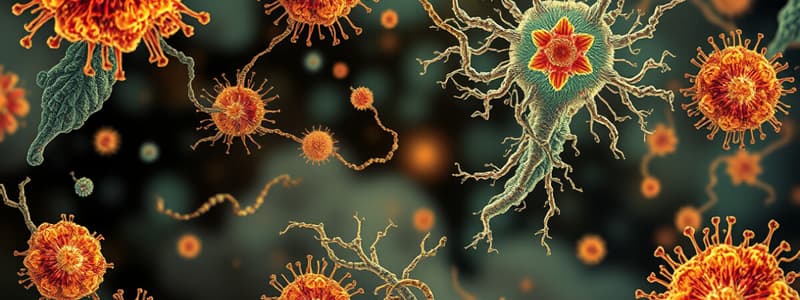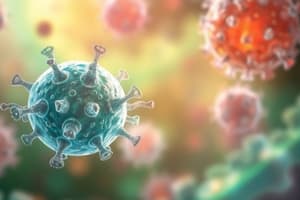Podcast
Questions and Answers
Which of the following are not considered microorganisms?
Which of the following are not considered microorganisms?
- Mosquitoes (correct)
- Viruses
- Fungi
- Bacteria
Helminths are categorized as which type of organism?
Helminths are categorized as which type of organism?
- Bacteria
- Parasitic worms (correct)
- Viruses
- Fungi
What type of microbiologist studies the influence of microbes in cave formations?
What type of microbiologist studies the influence of microbes in cave formations?
- Geomicrobiologist (correct)
- Environmental microbiologist
- Astrobiologist
- Geologist
Which of these pairs of career descriptions and work tasks is not correctly matched?
Which of these pairs of career descriptions and work tasks is not correctly matched?
What is the primary role of decomposers in an ecosystem?
What is the primary role of decomposers in an ecosystem?
What significant event regarding the origin of cells occurred about 3.5 billion years ago?
What significant event regarding the origin of cells occurred about 3.5 billion years ago?
Which of the following activities exemplifies biotechnology?
Which of the following activities exemplifies biotechnology?
Which area of biology discusses gradual structural and functional changes over long periods?
Which area of biology discusses gradual structural and functional changes over long periods?
Which characteristic is unique to viruses that differentiates them from bacteria and archaea?
Which characteristic is unique to viruses that differentiates them from bacteria and archaea?
Which group of microorganisms is composed solely of hereditary material surrounded by a protein coat?
Which group of microorganisms is composed solely of hereditary material surrounded by a protein coat?
How do eukaryotic cells compare in size to bacterial and archaeal cells?
How do eukaryotic cells compare in size to bacterial and archaeal cells?
What is the primary purpose of Koch's postulates?
What is the primary purpose of Koch's postulates?
Which of the following accurately defines sterile conditions?
Which of the following accurately defines sterile conditions?
What is the smallest and most significant taxon in biological classification?
What is the smallest and most significant taxon in biological classification?
What does the term microbiome refer to?
What does the term microbiome refer to?
Which of the following is NOT part of the scientific method?
Which of the following is NOT part of the scientific method?
Which historical microbiologist is incorrectly associated with his contribution?
Which historical microbiologist is incorrectly associated with his contribution?
In the context of taxonomy, what is a kingdom?
In the context of taxonomy, what is a kingdom?
Flashcards are hidden until you start studying
Study Notes
Microorganisms Overview
- Mosquitoes are not classified as microorganisms.
- Helminths are defined as parasitic worms.
- Viruses are categorized as noncellular microorganisms.
Immunology and Microbiology
- Immunologists study the immune response to infections caused by microorganisms.
- Industrial microbiologists do not manipulate bacterial strains to be less pathogenic.
Specialized Fields
- Geomicrobiology investigates the role of microbes in cave formation.
- Astrobiology studies the potential for microbial life beyond Earth.
- Decomposers recycle nutrients by breaking down dead matter and waste.
Energy and Nutrient Flow
- Majority of Earth's atmospheric oxygen results from microbial photosynthesis.
- The common ancestral cell gave rise to three cell types: eukaryotes, archaea, and bacteria, with the first cells appearing around 3.5 billion years ago.
Evolution and Biotechnology
- Evolution describes the gradual changes in living organisms over time.
- Genetic engineering involves humans manipulating microbial genes.
- A clear example of biotechnology is Escherichia coli producing human insulin.
Traditional Uses and Bioremediation
- Traditional human uses of microorganisms include baking bread.
- Bioremediation uses microbes to detoxify sites contaminated with heavy metals.
Pathogens and Infectious Diseases
- Pathogens are microorganisms that cause diseases.
- Respiratory diseases are the leading infectious diseases globally.
- The U.S. has fewer communicable disease-related deaths compared to other global regions.
Cellular Comparisons
- Bacteria and eukaryotes both possess a cell membrane.
- Archaea and eukaryotes share similar small subunit rRNA sequences.
- Viruses lack cell structure, setting them apart from other microorganisms.
- Viruses consist only of hereditary material wrapped in a protein coat.
Size and Scale of Cells
- Eukaryotic cells are generally ten times larger than bacterial or archaeal cells.
- Archaeal cells are similar in size to bacterial cells.
- Viruses are smaller than bacterial or archaeal cells but larger than macromolecules.
Historical Microbiology
- Louis Pasteur is incorrectly associated with demonstrating anthrax causation—his primary contributions were related to spontaneous generation.
- Pasteur used swan-necked flasks to allow air exposure while preventing bacteria from contaminating the broth.
Microbiological Standards
- Koch's postulates are used to identify specific microbes as causes of specific diseases.
- Recent discoveries significantly impact the understanding of microbiology.
- The microbiome encompasses all microbes within a particular environment.
Scientific Method and Taxonomy
- The scientific method excludes belief in preconceived ideas as a legitimate process.
- Experimentation is essential for obtaining objective data, while publication is not part of the method itself.
- Taxonomy focuses on the identification and classification of organisms without relying on common names.
Taxonomic Hierarchy
- Organisms are classified in a hierarchical structure, with classification defining the orderly arrangement into taxa.
- Kingdom is the highest taxon that encompasses all others.
- Species is the smallest and most significant taxon.
- Correct descending taxonomic order is Family, Genus, Species.
Studying That Suits You
Use AI to generate personalized quizzes and flashcards to suit your learning preferences.




